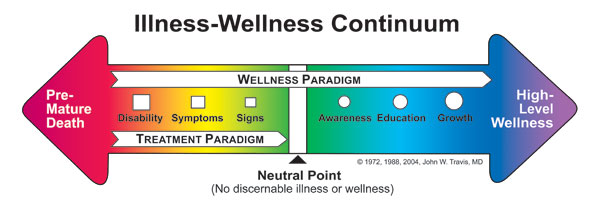Health – As defined by the World Health Organization (WHO): state of complete physical, mental and social well-being, not merely the absence of disease or infirmity.
a. Characteristics
i. A concern for the individual as a total system
ii. A view of health that identifies internal and external environment
iii. An acknowledgment of the importance of an individual’s role in life
A dynamic state in which the individual adapts to
changes in internal and external environment to maintain a state of well being
b. Models of Health and Illness
1. Health – Belief Model – Addresses the relationship between a person’s belief and behaviors. It provides a way of understanding and predicting how clients will behave in relation to their health and how they will comply with health care therapies.
Four Components
Ø The individual is perception of susceptibility to an illness
Ø The individual’s perception of the seriousness of the illness
Ø The perceived threat of a disease
Ø The perceived benefits of taking the necessary preventive
measures
2. Health Promotion Model – A “complimentary counterpart models of health protection”. Directed at increasing a client’s level of well being. Explain the reason for client’s participation health-promotion behaviors. The model focuses on three functions:
Ø It identifies factors (demographic and socially) enhance or decrease the participation in health promotion
Ø It organizes cues into pattern to explain likelihood of a client’s participation health-promotion behaviors
Ø It explains the reasons that individuals engage in health activities
3. Eudaemonistic model -most comprehensive, holistic, view of health; ability to become self actualized essential or fulfilment to the model health is actualization or realization of one’s potential illness is seen as the failure to actualize or realize one’s potential
4. Agent – Host – Environment/Ecologic Model (Leavell) – The level of health of an individual or group depends on the dynamic relationship of the agent, host and environment
Ø Agent – any internal or external factor that disease or illness.
Ø Host – the person or persons who may be susceptible to a
particular illness or disease
Ø Environment – consists of all factors outside of the host
5. Dunn’s High-Level Wellness Grid
c. composed of two axis’s
i. a health axes which ranges from peak wellness to death/ilness
ii. a environmental axes which ranges from very favorable to very unfavorable
d. the two axis’s form four quadrants
i. high-level wellness in a favorable environment
e.g., a person who implements healthy life-style behaviors and has the biopsychosocialspiritual resources to support this life-style
ii. emergent high-level wellness in an unfavorable environment
e.g., a woman who has the knowledge to implement healthy life-style practices but does not implement adequate self-care practices because of family responsibilities, job demands, or other factors
iii. protected poor health in a favorable environment
e.g., an ill person whose needs are met by the health care system and who has access to appropriate medications, diet, and health care instruction
iv. poor health in an unfavorable environment
e.g., a young child who is starving in a drought ridden country
c. composed of two axis’s
i. a health axes which ranges from peak wellness to death/ilness
ii. a environmental axes which ranges from very favorable to very unfavorable
d. the two axis’s form four quadrants
i. high-level wellness in a favorable environment
e.g., a person who implements healthy life-style behaviors and has the biopsychosocialspiritual resources to support this life-style
ii. emergent high-level wellness in an unfavorable environment
e.g., a woman who has the knowledge to implement healthy life-style practices but does not implement adequate self-care practices because of family responsibilities, job demands, or other factors
iii. protected poor health in a favorable environment
e.g., an ill person whose needs are met by the health care system and who has access to appropriate medications, diet, and health care instruction
iv. poor health in an unfavorable environment
e.g., a young child who is starving in a drought ridden country
6.Travis’ Illness-Wellness Continuum
- composed of two arrows pointing in opposite directions and joined at a neutral point
- movement to the right on the arrows (towards high-level wellness) equals an increasing level of health and well-being
- achieved in three steps:
- awareness
- education
- growth
- movement to the left on the arrows (towards premature death) equates a progressively decreasing state of health
- achieved in three steps:
- signs
- symptoms
- disability
- most important is the direction the individual is facing on the pathway
- if towards high-level health, a person has a genuinely optimistic or positive outlook despite his/her health status
- if towards premature death, a person has a genuinely pessimistic or negative outlook about his/her health status
- compares a treatment model with a wellness model
- if a treatment model is used, an individual can move right only to the neutral point
- e.g., a hypertensive client who only takes his medications without making any other life-style changes
- if a wellness model is used, an individual can move right past the neutral point


No comments:
Post a Comment